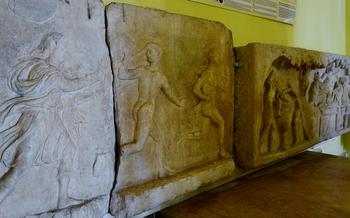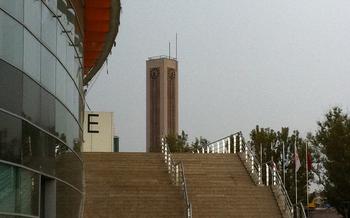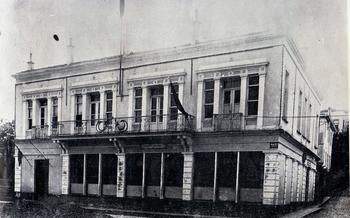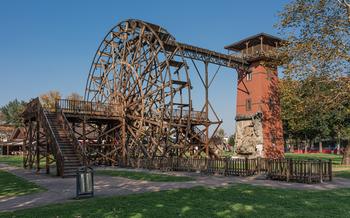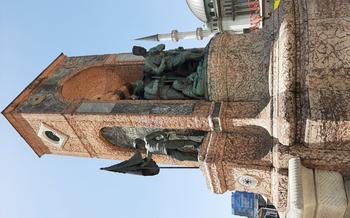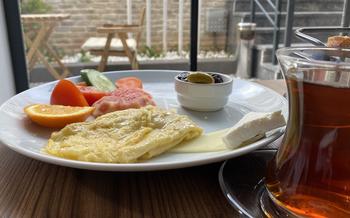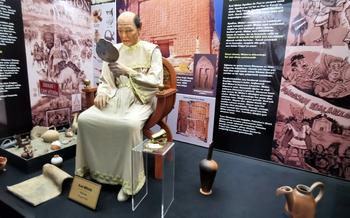
Saraydüzü Barracks National Struggle Museum
- Amasya: A City of History and Beauty
- Exploring the Saraydüzü Barracks National Struggle Museum
- A Walk Through Time
- The Role of Amasya in the Turkish War of Independence
- Witnessing History Unfold
- Immersive Experience at the Museum
- A Tribute to Turkish Resilience
- Exploring the Surrounding Area
- Unveiling Amasya's Hidden Gems
- Planning Your Visit
- A Journey into Turkish Culture
- Capturing Memories
- Practical Considerations
- Currency and Payment
- Language
- Communication
- Respecting the Past:
- Insider Tip: Unveiling Hidden Treasures
Amasya: A City of History and Beauty
Amasya, a city nestled in the heart of Turkey's northern Anatolian region, is a treasure trove of historical and natural wonders. Its rich past, dating back to ancient civilizations, has left an indelible mark on the city's landscape and culture. Amasya is adorned with stunning natural features, including the meandering Yeşilırmak River that gracefully divides the city, creating a picturesque panorama. The surrounding mountains and lush forests provide a breathtaking backdrop to this enchanting city, making it a popular destination for history buffs and nature enthusiasts alike.
Exploring the Saraydüzü Barracks National Struggle Museum
Location and Accessibility:
The Saraydüzü Barracks National Struggle Museum is situated in the heart of Amasya, Turkey. It is easily accessible by foot or public transportation from various parts of the city. Visitors can take a leisurely stroll along the picturesque streets of Amasya and reach the museum within a few minutes.
Historical Background and Significance:
The building that houses the museum served as a barracks during the Ottoman Empire and played a crucial role in the Turkish National Struggle. In 1919, Mustafa Kemal Atatürk, the founder of the Turkish Republic, established his headquarters at the Saraydüzü Barracks. From here, he led the Turkish resistance against the Allied forces and the Ottoman government.
The museum showcases the history of the Turkish National Struggle and the pivotal role that Amasya played in this significant event. Visitors can learn about the challenges faced by the Turkish people during the war and the heroic efforts of Mustafa Kemal Atatürk and his comrades.
A Walk Through Time
The Saraydüzü Barracks National Struggle Museum takes visitors on a journey through time, showcasing the momentous events of the Turkish National Struggle. Through a captivating display of artifacts, documents, and interactive exhibits, the museum brings to life the heroic stories of the Turkish people's fight for independence. Visitors can trace the chronological progression of the struggle, beginning with the outbreak of World War I and the subsequent collapse of the Ottoman Empire. The museum highlights the significant role of Mustafa Kemal Atatürk, the founder of modern Turkey, in leading the resistance against foreign occupation. One of the museum's most poignant displays is a replica of Atatürk's office, where he strategized and issued orders during the war. Visitors can also view personal belongings and uniforms of Turkish soldiers, gaining insights into their determination and sacrifices.
The Role of Amasya in the Turkish War of Independence
Amasya played a pivotal role during the Turkish War of Independence, serving as a crucial strategic center and a hub for the Turkish resistance movement. The city's strategic location at the crossroads of Anatolia made it a vital point of control for the Turkish forces. Amasya became a sanctuary for the Turkish Nationalists, who sought refuge from the invading Allied powers and the collapsing Ottoman government.
Under the leadership of Mustafa Kemal Atatürk, the founder of the Turkish Republic, Amasya became a center for organizing and mobilizing the Turkish resistance. The city hosted the famous Amasya Circular, a crucial document issued in 1919 that outlined the principles and objectives of the Turkish National Movement. This circular called for the establishment of a provisional government in Ankara and the rejection of the Treaty of Sèvres, which aimed to partition the Ottoman Empire.
Amasya's contributions to the war effort were multifaceted. The city served as a base for military operations, providing logistical support and supplies to the Turkish forces. It also became a center for propaganda and dissemination of information, galvanizing support for the national cause. Amasya's role as a safe haven for the Turkish Nationalists allowed them to regroup, strategize, and plan their resistance against the Allied forces.
The city's strategic importance extended beyond its military significance. Amasya's symbolic value as a bastion of Turkish resistance and a birthplace of the national movement made it a powerful rallying point for the Turkish people. The city's steadfast resistance and unwavering commitment to independence inspired hope and determination throughout the country, contributing to the ultimate success of the Turkish War of Independence.
Witnessing History Unfold
The Saraydüzü Barracks National Struggle Museum houses a treasure trove of artifacts that vividly depict the Turkish National Struggle. Among the highlights of the collection are personal belongings of Mustafa Kemal Atatürk, the founder of modern Turkey, including his uniforms, hats, and handwritten notes. Visitors can also see weapons, ammunition, and other military equipment used during the war, providing a tangible connection to the sacrifices made by the Turkish people.
One of the most poignant exhibits is a collection of letters and telegrams exchanged between Atatürk and his commanders on the front lines. These messages offer a glimpse into the strategic decisions and challenges faced by the Turkish leadership during the war. Visitors can also view maps and battle plans that illustrate the course of the conflict and the decisive victories achieved by the Turkish forces.
The museum also features multimedia presentations and interactive displays that bring the history of the Turkish War of Independence to life. Visitors can watch documentaries, listen to audio recordings of speeches and interviews, and even participate in virtual simulations of key battles. These interactive elements enhance the museum experience and make it accessible to visitors of all ages and backgrounds.
Immersive Experience at the Museum
The Saraydüzü Barracks National Struggle Museum offers a range of facilities and programs to enhance visitors' experience and understanding of the museum's exhibits. Guided tours are available, led by knowledgeable and passionate guides who share in-depth insights into the history of the Turkish National Struggle and the significance of the museum's artifacts. These guided tours provide a deeper understanding of the events that unfolded within the barracks and the impact they had on the course of the war.
For those who prefer a more personalized experience, audio guides are available in multiple languages, allowing visitors to explore the museum at their own pace and delve into the stories and information presented in each exhibit. Interactive displays and multimedia presentations bring the museum's collection to life, providing a captivating and engaging experience for visitors of all ages.
Educational programs and workshops are also conducted at the museum, offering a unique opportunity for students, researchers, and history enthusiasts to gain a comprehensive understanding of the Turkish War of Independence and its significance. These programs provide a platform for interactive learning, discussions, and hands-on activities, fostering a deeper appreciation for the historical events that shaped modern Turkey.
A Tribute to Turkish Resilience
The Saraydüzü Barracks National Struggle Museum serves as a powerful reminder of the indomitable spirit of the Turkish people during the War of Independence. It is a testament to their resilience, determination, and unwavering belief in their national identity.
The museum's exhibits and displays pay homage to the sacrifices made by countless individuals who fought for Turkey's freedom and sovereignty. Through interactive displays and multimedia presentations, visitors gain a deeper understanding of the challenges and triumphs faced by the Turkish people during this pivotal period.
The museum stands as a symbol of Turkish resilience, reminding visitors of the strength and courage that emerged from a time of adversity. It is a tribute to the collective spirit of the nation and a source of inspiration for future generations.
Exploring the Surrounding Area
Beyond the walls of the Saraydüzü Barracks National Struggle Museum, Amasya unveils a treasure trove of historical and cultural attractions within easy reach. Take a leisurely stroll along the picturesque Yeşilırmak River, where you can admire the stunning views of the city's iconic bridges and lush green landscapes.
A short walk from the museum leads you to the Amasya Castle, a majestic fortress that has stood witness to centuries of history. Explore its ramparts, towers, and dungeons, and soak in the panoramic vistas of the city and the river below.
Step into the realms of spirituality at the Sultan Bayezid II Mosque, a magnificent architectural marvel known for its intricate tilework and stunning calligraphy. Adorned with domes and minarets, this sacred site offers a glimpse into the religious heritage of Amasya.
Don't miss the opportunity to visit the Amasya Museum, which houses an eclectic collection of artifacts shedding light on the city's rich past. From ancient pottery and sculptures to traditional costumes and handicrafts, this museum offers a comprehensive journey through time.
As you wander through the charming streets of Amasya, stumble upon hidden gems like the Tokatlı Canyon, a natural wonder that boasts breathtaking rock formations and cascading waterfalls. Immerse yourself in the tranquility of nature as you traverse this scenic gorge.
For a taste of local flavors, head to the vibrant Amasya Bazaar, where you can savor an array of traditional Turkish delicacies, including the famous Amasya apples, renowned for their sweetness and crispness. Browse through the colorful stalls selling artisanal crafts, jewelry, and souvenirs, capturing the essence of Amasya's vibrant culture.
Unveiling Amasya's Hidden Gems
Beyond the museum's walls, Amasya holds a treasure trove of hidden gems waiting to be discovered. Savor the delectable flavors of local cuisine, where Turkish delights intertwine with regional specialties. Indulge in the art of traditional handicrafts, from intricate pottery to handwoven textiles. Take home unique souvenirs that capture the essence of Amasya's rich heritage. Explore the vibrant local markets, where the air is filled with the aroma of spices and the buzz of friendly haggling. Uncover hidden courtyards and charming cafes tucked away from the main tourist routes. As you wander through the city's narrow streets, keep an eye out for remnants of the past, such as ancient ruins or historic mansions that tell stories of Amasya's bygone eras.
Planning Your Visit
The Saraydüzü Barracks National Struggle Museum welcomes visitors from all over the world to explore its rich collection and immerse themselves in the history of the Turkish National Struggle. To make the most of your visit, here are some practical details to consider:
Opening Hours: The museum is open every day of the week, except for Mondays, from 8:00 AM to 5:00 PM.
Admission Fees: Entrance to the museum is free of charge, allowing everyone to access and appreciate its historical treasures without any financial barriers.
Recommended Duration: To fully immerse yourself in the exhibits and the stories they tell, plan to spend at least two hours exploring the museum. This will give you ample time to wander through the galleries, engage with the interactive displays, and absorb the significance of the artifacts on display.
A Journey into Turkish Culture
A visit to Amasya and the Saraydüzü Barracks National Struggle Museum is not just a journey through history but also an immersion into the vibrant culture of Turkey. While exploring this captivating city, embrace the opportunity to interact with the warm and welcoming locals and learn about their customs and traditions.
Local Customs and Traditions:
-
Greetings: A friendly smile and a handshake or a nod are common ways to greet people in Turkey. When meeting someone for the first time, it is customary to use the person's title and last name until invited to do otherwise.
-
Respect for Elders: Age is highly respected in Turkish culture. Always show deference to older individuals by addressing them politely and using formal language.
-
Hospitality: Turks are renowned for their hospitality. Accepting an invitation to share a meal or a cup of tea is considered a sign of respect and friendship.
Etiquette and Respectful Interactions:
-
Dress Code: While there is no strict dress code, modest attire is generally preferred, especially when visiting religious sites or conservative areas.
-
Body Language: Avoid excessive public displays of affection, as it is considered inappropriate in Turkish culture.
-
Photography: Always ask permission before taking photographs of people, especially women.
-
Language: While Turkish is the official language, English is widely spoken in tourist areas. Learning a few basic Turkish phrases can go a long way in showing respect and appreciation for the local culture.
Capturing Memories
The Saraydüzü Barracks National Struggle Museum is a treasure trove of history and culture, and capturing its essence through photography is a wonderful way to preserve your memories. As you wander through the exhibits, be sure to take your time to observe the details and appreciate the stories they tell. While photography is allowed within the museum, it is important to be mindful of the following guidelines:
-
Flash Photography: To protect the delicate artifacts and exhibits, flash photography is strictly prohibited within the museum. Natural light or low-light settings on your camera are recommended to avoid causing any damage.
-
Tripods: Tripods are not permitted inside the museum to ensure the safety of visitors and the exhibits. Handheld photography is encouraged to maintain a smooth flow of movement throughout the galleries.
-
Respectful Photography: Remember that the museum is a place of remembrance and reflection for many visitors. Be respectful of others who may be quietly contemplating the exhibits and avoid disturbing their experience with loud conversations or intrusive photography.
-
Social Media Sharing: Share your experiences and discoveries with the world by using relevant hashtags related to the museum and the city of Amasya. This helps promote the museum's mission and encourages others to explore this historic site.
Practical Considerations
When preparing for your visit to the Saraydüzü Barracks National Struggle Museum, there are a few practical considerations to keep in mind.
Currency and Payment
The official currency of Turkey is the Turkish Lira (TRY). Major credit cards, such as Visa and Mastercard, are widely accepted at the museum. However, it's always advisable to carry some local currency for smaller purchases or tips. Currency exchange services are available at the airport and in various banks and exchange bureaus throughout the city.
Language
The primary language spoken in Turkey is Turkish. While English is understood and spoken by many in the tourism industry, it's helpful to have a basic grasp of Turkish phrases or gestures to communicate with locals and navigate effectively.
Communication
To overcome language barriers, consider downloading a translation app on your smartphone or bringing a phrasebook. Additionally, the museum provides audio guides in various languages, including English, to enhance your understanding of the exhibits.
Respecting the Past:
As you wander through the halls of the Saraydüzü Barracks National Struggle Museum, it is essential to remember that you are in a place of profound historical significance. The exhibits and artifacts on display are not just relics of the past, but tangible reminders of the sacrifices and struggles that shaped Turkey's destiny. It is crucial to treat these treasures with the utmost respect and care.
Refrain from touching or leaning on the exhibits, as they are delicate and irreplaceable. Be mindful of your surroundings and ensure that you do not disrupt other visitors' experiences. Silence your mobile phones and refrain from engaging in loud conversations, allowing everyone to immerse themselves fully in the atmosphere of the museum.
Remember that the Saraydüzü Barracks National Struggle Museum is not just a tourist attraction but a place of remembrance and reflection. By respecting the past and preserving the historical integrity of the site, you are contributing to its legacy and ensuring that future generations can continue to learn from and appreciate this remarkable chapter in Turkish history.
Insider Tip: Unveiling Hidden Treasures
As you wander through the Saraydüzü Barracks National Struggle Museum, keep an eye out for hidden corners and lesser-known exhibits that offer a deeper glimpse into Turkish history. In a secluded alcove, you might stumble upon a collection of personal artifacts belonging to Mustafa Kemal Atatürk, the revered founder of the Turkish Republic. These intimate objects, ranging from his field notebook to his worn-out military uniform, provide a tangible connection to the man who played a pivotal role in shaping Turkey's destiny.
For a breathtaking panoramic view of Amasya, venture to the museum's rooftop terrace. From this vantage point, you can survey the city's sprawling cityscape, dotted with historical landmarks and surrounded by the majestic peaks of the Pontic Mountains. As you gaze upon this stunning vista, let your imagination transport you back to the tumultuous days of the Turkish National Struggle, when Amasya served as a strategic hub for the resistance movement.
By exploring these hidden gems within the museum, you'll gain a profound understanding of Turkey's rich history and the indomitable spirit of its people. These secret spots offer a unique opportunity to connect with the past and appreciate the remarkable journey that has shaped modern-day Turkey.

